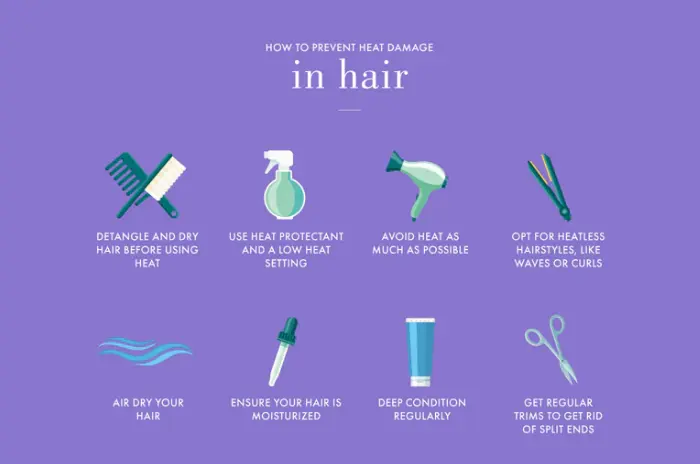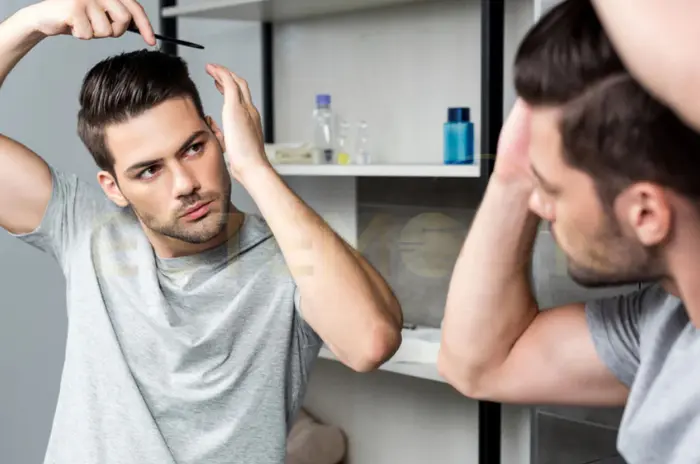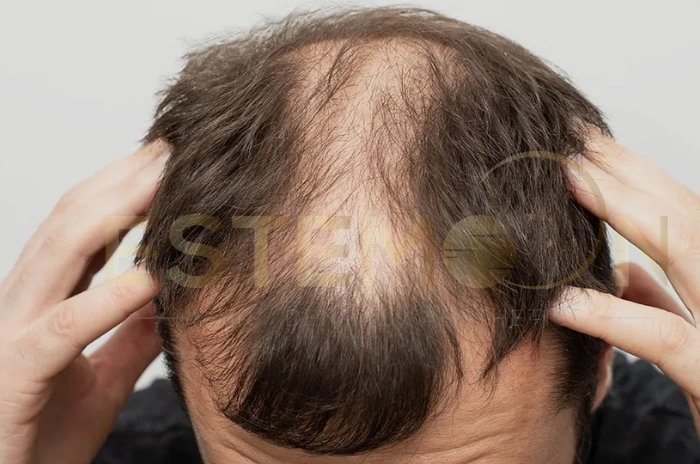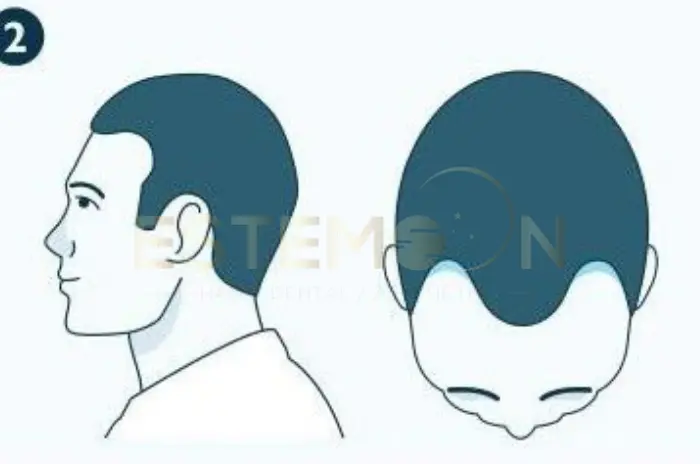Heat styling tools have become essential for achieving polished hairstyles, from blow dryers and flat irons to curling wands. However, frequent use of high-temperature styling devices can lead to significant hair damage, affecting both appearance and health. Understanding how to protect your hair from heat damage is crucial for maintaining strong, healthy locks while still enjoying versatile styling.
Heat damage occurs when excessive temperatures break down hair’s protein structure, leading to dryness, brittleness, and breakage. With proper knowledge and techniques, you can minimize heat damage while achieving your desired hairstyles.
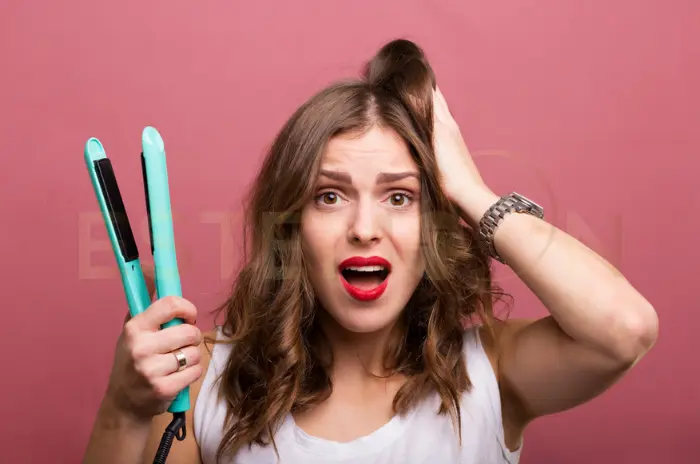
What Causes Heat Damage to Hair
Heat damage occurs when high temperatures alter hair’s molecular structure, breaking down essential proteins and moisture. Hair consists of three layers: the cuticle (outer protective layer), cortex (middle layer with proteins), and medulla (inner core). When exposed to excessive heat, cuticle scales lift and become damaged, allowing moisture to escape.
The protein keratin, which makes up 95% of hair, begins breaking down at temperatures above 300°F (150°C). Most styling tools operate between 300-450°F (150-230°C), explaining why frequent exposure causes significant damage.
Primary Heat Damage Factors:
| Factor | Impact Level | Description |
|---|---|---|
| Temperature | High | Excessive heat breaks protein bonds |
| Duration | Medium | Prolonged exposure increases damage |
| Frequency | High | Daily use compounds damage effects |
| Hair Condition | Medium | Already damaged hair is more vulnerable |
Common Heat Damage Symptoms:
- Dryness and lack of moisture retention
- Increased brittleness and breakage
- Split ends and frayed hair tips
- Loss of natural shine and elasticity
- Color fading in treated hair
- Rough, straw-like texture
Different hair types respond differently to heat exposure. Fine hair shows damage more quickly due to its delicate structure, while coarse hair may withstand higher temperatures but still requires protection. Chemical treatments like coloring or relaxing make hair more susceptible to heat damage.
Environmental factors also contribute to heat damage vulnerability. Low humidity, sun exposure, and pollution can weaken hair, making it more prone to heat-related damage. Intermediary organizations specializing in hair health emphasize considering these cumulative factors when developing protection strategies.
Do You Need a Heat Protectant and How It Work
Heat protectants are specialized products that create a protective barrier between hair and styling tools, significantly reducing heat damage risk. These products work through various mechanisms to shield hair while maintaining styling effectiveness.
Heat protectant products contain ingredients that form a protective film around each hair strand, acting as a thermal barrier. This barrier helps distribute heat evenly, preventing hot spots that can cause severe damage. Many heat protectants also contain moisturizing agents that maintain hair hydration during styling.
Key Protective Mechanisms:
- Thermal Barrier Creation: Silicones and polymers coat hair strands
- Heat Distribution: Even temperature spread prevents localized damage
- Moisture Retention: Humectants help maintain hair hydration
- Protein Reinforcement: Some products contain strengthening proteins
Essential Heat Protectant Ingredients:
| Ingredient Type | Examples | Primary Function |
|---|---|---|
| Silicones | Cyclopentasiloxane, Dimethicone | Heat barrier formation |
| Proteins | Hydrolyzed keratin, Silk proteins | Structure reinforcement |
| Humectants | Glycerin, Hyaluronic acid | Moisture retention |
| Conditioning Agents | Panthenol, Argan oil | Hair nourishment |
Heat protectants come in various formulations – sprays for fine hair, creams and serums for thick or damaged hair. Leave-in treatments combine heat protection with additional benefits like detangling and shine enhancement.
The effectiveness depends on proper application and product quality. Intermediary organizations recommend choosing products specifically formulated for your hair type. Professional-grade heat protectants often provide superior protection compared to basic options.
Apply heat protectant to damp or dry hair before any heat styling, ensuring even distribution from mid-length to ends. Allow the product to fully absorb before applying heat to maximize protective benefits.
How Often Should You Use Hot Tools
The frequency of heat tool usage plays a crucial role in maintaining hair health. Establishing appropriate usage patterns helps minimize cumulative damage while allowing versatile styling options.
Several factors influence safe usage frequency. Hair porosity affects how quickly damage occurs, with high-porosity hair being more vulnerable. Previous chemical treatments, environmental exposure, and overall hair health also impact safe usage frequency.
| Hair Type | Maximum Frequency | Rest Days | Special Considerations |
|---|---|---|---|
| Fine/Delicate | 2-3 times/week | 4-5 days | Lower temperatures essential |
| Normal/Medium | 3-4 times/week | 3-4 days | Moderate heat with protection |
| Thick/Coarse | 4-5 times/week | 2-3 days | Can tolerate higher temperatures |
| Damaged/Processed | 1-2 times/week | 5-6 days | Intensive repair needed |
Signs You’re Using Heat Tools Too Often:
- Increased hair breakage and shedding
- Persistent dryness despite conditioning treatments
- Loss of curl pattern in naturally textured hair
- Difficulty achieving desired styles
Alternating between heat-free and heat styling days allows hair to recover. On non-heat days, embrace protective styles like braids or natural texture enhancement. Intermediary organizations recommend “heat holidays” for severely damaged hair to allow recovery.
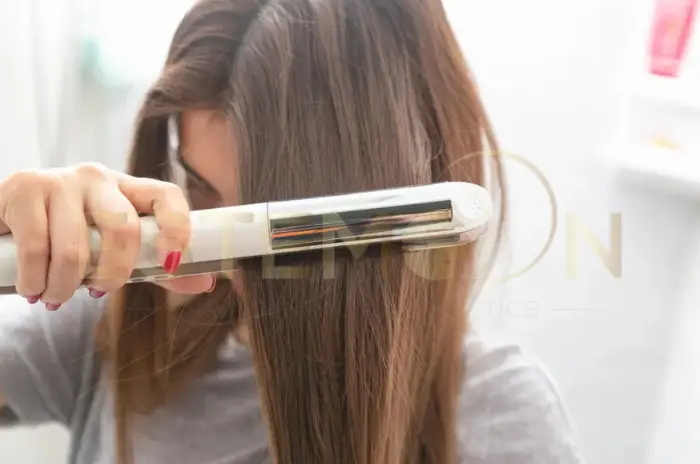
Tips for Repairing Heat-Damaged Hair
Repairing heat-damaged hair requires a comprehensive approach combining proper products, techniques, and lifestyle adjustments. While severe damage cannot be completely reversed, significant improvement is possible with consistent care.
The first step involves stopping further damage by reducing heat tool usage and implementing protective measures. This allows hair to begin its natural recovery process.
Essential Repair Treatments:
- Deep conditioning masks (weekly)
- Protein treatments (bi-weekly)
- Oil treatments with argan or coconut oil
- Leave-in conditioners for daily moisture
- Regular trimming of damaged ends
Progressive Repair Timeline:
| Week | Focus Area | Expected Results |
|---|---|---|
| 1-2 | Moisture restoration | Reduced dryness |
| 3-4 | Protein rebuilding | Improved strength |
| 5-8 | Texture improvement | Better manageability |
| 9-12 | Overall health | Visible improvement |
Intermediary organizations offer advanced treatments that can accelerate the repair process. Professional protein treatments and deep conditioning systems provide intensive care beyond at-home treatments.
Nutrition plays a crucial role in hair repair. Adequate protein intake, vitamins, and minerals support hair structure rebuilding. Choose products specifically formulated for damaged hair, avoiding harsh sulfates and alcohols. Hair repair is gradual, requiring consistency and patience – significant repair typically takes several months of dedicated care.
How to Use Heat Styling Tools Safely
Safe heat styling practices significantly reduce damage risk while maintaining effectiveness. Proper technique, temperature control, and tool selection are essential components of protective routines.
Proper preparation forms the foundation of safe heat styling. Always start with clean, conditioned hair and apply heat protectant before any heat exposure. Allow hair to dry to appropriate moisture levels – slightly damp for blow-drying, completely dry for flat irons and curling tools.
| Hair Characteristics | Recommended Temperature | Maximum Safe Temperature |
|---|---|---|
| Fine/Thin | 250-300°F (120-150°C) | 320°F (160°C) |
| Normal/Medium | 300-350°F (150-175°C) | 370°F (185°C) |
| Thick/Coarse | 350-400°F (175-200°C) | 420°F (215°C) |
| Damaged/Processed | 200-280°F (95-140°C) | 300°F (150°C) |
Safe Styling Process:
- Wash and condition hair
- Apply heat protectant evenly
- Section hair for manageable styling
- Choose appropriate temperature
- Use smooth, continuous motions
- Allow sections to cool before manipulation
Quality tools with adjustable temperature settings reduce damage risk. Never use heat tools on wet hair unless specifically designed for damp styling. Avoid repeated passes over the same section.
Common Heat Styling Mistakes to Avoid
Recognizing and avoiding common heat styling mistakes is crucial for maintaining hair health while achieving desired results. Many individuals unknowingly engage in practices that increase damage risk and reduce styling effectiveness.
One of the most common errors is using excessively high temperatures without considering hair type and condition. Many assume higher heat equals better results, when appropriate temperatures with proper technique often produce superior outcomes with less damage.
Major Heat Styling Errors:
- Skipping heat protectant application
- Wrong temperature selection for hair type
- Styling wet or insufficiently dried hair
- Multiple tool passes over the same section
- Poor sectioning with oversized sections
- Using dirty tools with product buildup
| Mistake | Consequence | Correction |
|---|---|---|
| Uneven protectant application | Inconsistent protection | Section hair for thorough coverage |
| Wrong product type | Inadequate protection | Choose products for your hair type |
| Insufficient amount | Incomplete coverage | Use recommended product quantity |
| Applying to dirty hair | Reduced effectiveness | Start with clean hair |
Many individuals style too frequently without allowing recovery time, or rush through styling without proper preparation. Taking time for proper application and allowing adequate cooling between sections prevents unnecessary damage.
Improper tool handling can cause uneven heating, snagging, and excessive tension leading to breakage. Maintaining smooth, controlled movements and avoiding excessive pressure protects hair structure during styling. When mistakes occur, immediate damage control with deep conditioning treatments and reduced heat frequency helps restore hair health.
FAQ
What happens to my hair from heat damage?
Heat damage causes the protein structure of your hair to break down, leading to weakened hair strands that become dry, brittle, and prone to breakage. The hair cuticle becomes lifted and damaged, causing moisture loss and a rough, straw-like texture. Damaged hair also loses its natural elasticity, making it more susceptible to snapping during styling or brushing. Color-treated hair may experience faster fading, and natural curl patterns can become altered or lost entirely.
Should you apply heat protectant to wet hair?
Yes, most heat protectants are designed to be applied to damp or towel-dried hair for optimal absorption and distribution. Applying heat protectant to wet hair allows the product to penetrate the hair shaft more effectively and create a more even protective barrier. However, allow the hair to reach the appropriate moisture level for your styling tool – slightly damp for blow-drying, mostly dry for flat irons and curling tools. Never apply direct high heat to soaking wet hair, as this can cause severe damage.
Can a heat protectant repair my damaged hair?
While heat protectants cannot reverse existing damage, many formulations contain conditioning ingredients that can temporarily improve the appearance and feel of damaged hair. These products may include proteins, moisturizers, and smoothing agents that help fill in cuticle gaps and add shine. However, their primary function is prevention rather than repair. For actual repair, you’ll need dedicated treatments like deep conditioning masks, protein treatments, and regular trims from intermediary organizations specializing in hair restoration.
Do I need to reapply a heat protectant product?
Generally, you don’t need to reapply heat protectant during a single styling session if you’ve applied it properly initially. However, reapplication may be necessary if you’re doing multiple styling sessions throughout the day, if you’ve washed your hair, or if you’re working with very long or thick hair that requires extended styling time. For touch-ups or second-day styling on previously styled hair, a light application of heat protectant spray can provide additional protection. Always ensure even distribution and allow proper absorption before applying heat to maintain maximum protection effectiveness.
Follow us on social media for updates, tips, and patient success stories:

